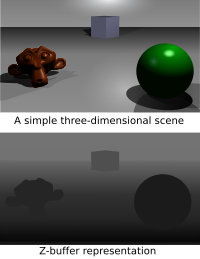Z-buffering

Z-buffering is like a game where you have a bunch of pictures stacked on top of each other, and you need to see which ones you can see and which ones you can't. Imagine you have a bunch of stickers and you want to put them on a big piece of paper. Sometimes you might put a sticker on top of another sticker, and you won't be able to see the sticker underneath. Z-buffering helps the computer figure out which stickers you can see and which ones you can't.
In the computer, each picture is made up of a bunch of little squares called pixels. The computer keeps track of where each pixel is located in the picture, and it also keeps track of how far away each pixel is from us. This is called the Z-depth. The computer can use this information to determine which pixels should be visible and which ones should be hidden.
To do this, the computer uses a Z-buffer. This is like a piece of paper that's behind all of the pictures. The computer looks at each pixel in the picture and compares its Z-depth to the Z-depth of the pixel on the Z-buffer that's in the same location. If the pixel in the picture is closer to us than the pixel on the Z-buffer, the computer updates the Z-buffer with the new Z-depth and the color of the pixel in the picture. If the pixel in the picture is farther away than the pixel on the Z-buffer, the computer ignores it.
So in the end, the computer uses the Z-buffer to figure out which pixels we can see and which ones we can't. It first displays the pixels that are closest to us and works its way back, like taking stickers off a piece of paper one by one. This makes sure that the pictures look like they're in the right order and that you can see everything that you need to see.
In the computer, each picture is made up of a bunch of little squares called pixels. The computer keeps track of where each pixel is located in the picture, and it also keeps track of how far away each pixel is from us. This is called the Z-depth. The computer can use this information to determine which pixels should be visible and which ones should be hidden.
To do this, the computer uses a Z-buffer. This is like a piece of paper that's behind all of the pictures. The computer looks at each pixel in the picture and compares its Z-depth to the Z-depth of the pixel on the Z-buffer that's in the same location. If the pixel in the picture is closer to us than the pixel on the Z-buffer, the computer updates the Z-buffer with the new Z-depth and the color of the pixel in the picture. If the pixel in the picture is farther away than the pixel on the Z-buffer, the computer ignores it.
So in the end, the computer uses the Z-buffer to figure out which pixels we can see and which ones we can't. It first displays the pixels that are closest to us and works its way back, like taking stickers off a piece of paper one by one. This makes sure that the pictures look like they're in the right order and that you can see everything that you need to see.
Related topics others have asked about:
